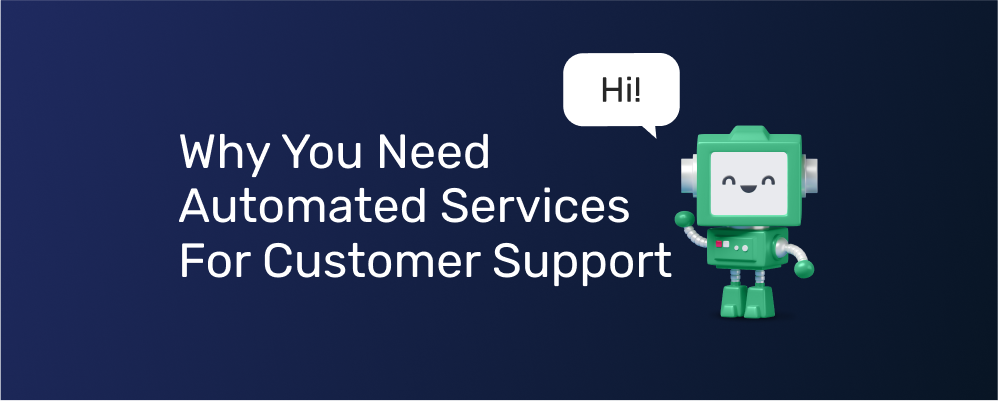Why You Need Automated Services For Customer Support

Hello, everybody!
Welcome to the fourth article in our “MythBusters” series, where we dismantle popular myths about marketing practices, like the hosts of the famous TV show Adam and Jamie did.
We have already destroyed the myths about the sameness of CRM and marketing automation tools, the uselessness of SMS marketing, and the suitability of someone else’s marketing strategies for your company. Today, we’ll bust another popular myth — “Everyone wants to talk to a human and hates automated services.”
Once again, we, unfortunately, won’t spectacularly blow up anything (except, maybe, your mind 🤯).
Most of you who have dealt with lousy chatbots will agree with this. And that’s why we’re eager to debunk this myth — to prove that tech solutions can be as helpful as people and show you the beauty of chatbots and autoreply services for your support department.
Let’s smooth out our mustaches (yes, we’ve all grown mustaches like Jamie’s) and start by defining the origins of the myth.
The origin of the myth
The best myths don’t have a single origin; they thrive in retelling. Consider Greek, Roman, and Nordic mythology.
People also invented the myth that everyone wants to communicate with a human agent. But, in this case, we can see that they earned the right to do so.
All thanks to a negative personal experience of communicating with customer service chatbots or Interactive Voice Response (IVR) systems (let’s call them robots for the sake of simplicity).
As a result, we can often hear that:
Robots are irritating
“If your issue is… press 1; if your issue is … press 2; if your issue is … press 5.” And so it drones on. Oh, wait! Did you accidentally press the wrong button? Then back to the start for you!
This is what a regular conversation with a poorly configured IVR looks like. And it often ends with a phone being chucked across the room.
Or, if you were unlucky enough to get a low-quality virtual agent — an AI-driven assistant that can recognize speech — the phone sails away after the tenth cry of, “I said, Jim! Not jam!”.
You can’t skip steps and go straight to talking with a real customer support agent — a live person. And this is the most irritating thing with poorly configured systems. As the author of one blog post neatly summarized it:
“When I talk to you, Mr. (or Ms.) Robot, you want me to do things your way – in a series of defined steps and disregard what I want you to do.” Sounds nice for managers who deal with Karens daily but annoying for most customers.
Robots aren’t that helpful
When most of your conversations with bots end by transferring to a human agent, you may think interaction with a bot was unnecessary.
Especially if the agent forces you to repeat all your answers.
And when people are sick of it, they go onto forums and recommend simply responding with gibberish from the get-go to be directed to a human agent.
Does that help customers in the moment? Maybe. Does it help to improve customer experience with a chatbot and make them more helpful? Not at all.
Robots can’t be personal
Bots used in customer service can’t yet imitate human conversation 100%.
For some people, this is the major reason to dislike chatbots and always require human agents. Here is one netizen’s opinion:
“Sorry, R2-D2, you’re just so cold and unemotional that I could never bring myself to [hug] you, and I’m sure you’d never appreciate or enjoy my hugs anyway”.
Well, R2-D2 is a cutie, so the point about hugging is arguable. But the general idea is clear — bots cannot provide personalization and the human touch, so they shouldn’t be used.
The common thread to believing bots are useless is poor-quality performance. But what changes if a company uses advanced technologies, virtual agents, and AI-based chatbots for customer service? Let’s see.
What customer service bots can actually do
Unless you’ve been living under a rock for the last few months, you’ve probably witnessed the hype around ChatGPT and other AI-based technologies. And so you know that chatbots, especially AI-powered ones, can be useful. Threateningly useful.
Luckily for us, AI-powered technologies work for people (for now) and, when applied with knowledge, easily debunk the statements that hold our “myth of the day” together.
Allow us to prove it.
Chatbots help customers and employees
When customers don’t answer with gibberish, bots handle 69% of chats from start to finish. Sure, human agents should finish the other 31% of conversations when the bot cannot find an answer to a complicated question or doesn’t understand a Scottish accent.
Still, a company can solve seven out of ten issues without using its staff. For example, you don’t need a real person answering calls to book a table, track a package, or leave an angry review. Sure, yelling at a real person is more satisfactory, but, on the other hand, a bot can’t yell back at you.
And another marvelous feature of bots is they keep support agents sane by collecting customers’ basic information. If you think it isn’t that important, try asking for names, phone numbers, and problems with you from dozens of people daily. What an uplifting and fun activity!🙄
Speaking with bots can actually be satisfactory
Many people actually like bots and prefer them over people. Does this have something to do with the creeping social anxiety of Millennials and Zoomers? Probably, considering that 42% of people would rather scrub a toilet than call a human customer support agent.
Or maybe it means well-configured chatbots and virtual agents aren’t that irritating? Yeah, this also makes sense. For example, using chatbots, Elkjøp’s company reached an 80% user satisfaction rate.
Automation provides personalization
Personalization is key to good customer service and satisfaction. And it might sound paradoxical, but automated systems, aka chatbots and other technologies for customer service with autoreply, can provide a higher level of personalization than people. How? By collecting and analyzing customers’ data from previous interactions in seconds and generating suitable answers. A person might miss or forget some details, while systems don’t forget anything (yes, even your browser history😏)
But can they seem human? Yes, they can. According to PwC research in 2017, 27% of consumers were unsure whether they talked to a chatbot or a human during their last interaction. And that was six years ago — can you imagine what they’re capable of now?
Yes, advanced human-like technologies in support services aren’t available to most companies due to their high cost. Still, the functionality of the existing ones is enough for most customers who don’t need to hug customer service employees. For example, according to Userlike company, 35% of customers found a simple chatbot friendly and highlighted this as a positive aspect.
These facts should have convinced you that not all people need human support agents to solve their issues. Still, here are a couple more figures for good measure.
- 62% of customers would rather use a chatbot than wait for a support agent to respond.
- 69% of customers were satisfied with the last interaction with the chatbot, and 10% gave a neutral rating to the quality of the conversation.
- 40% of customers don’t care if they talk to a human or bot if their problem is solved.
“Okay, some people don’t mind bots. How can this help me?” — you might ask. We have an answer to that.
Why do you need bots?
Any bot in support service makes the work of your employees easier and more productive through automation. Let’s summarize these features to distinguish their benefits. So, bots can:
Not all customers require support agents. What does this mean for you?
The myth is busted, and for you, this means only one thing — you can adopt chatbots, virtual agents, or IVR without fear of losing your customers.
BUT! Do it wisely, as bots can’t replace people entirely.

Automation systems still can’t solve all customer issues, and you need people to handle complex and unusual requests.
Some people still reject progress and want to call support services even with minor problems. Just accept this.
Take time to choose the right type of bot for your customers, and be sure to tailor its settings to provide the best possible service and customer experience.
Only by keeping a balance between quick and easy support solutions provided by bots and personal interactions with agents can you achieve outstanding results.